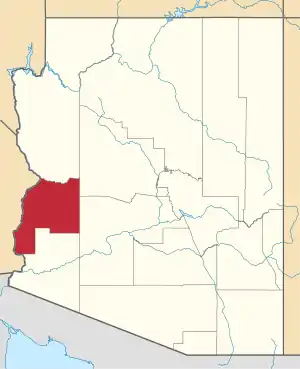La Paz, Arizona
La Paz (Yavapai: Wi:hela) was a short-lived early gold mining town along on the western border of current-day La Paz County, Arizona. The town grew quickly after gold was discovered nearby in 1862. La Paz, Spanish for peace, was chosen as the name in recognition of the feast day for Our Lady of Peace.[2] Originally located in the New Mexico Territory, the town became part of the Arizona Territory when President Abraham Lincoln established the new territory in 1863.[3] In 1983 the newly-formed County of La Paz adopted the name, long after the town had become a ghost town.
La Paz, Arizona | |
|---|---|
 La Paz Location in the state of Arizona  La Paz La Paz (the United States) | |
| Coordinates: 33°40′45″N 114°25′35″W | |
| Country | United States |
| State | Arizona |
| County | La Paz |
| Founded | 1862, before Arizona was officially declared a territory by President Abraham Lincoln |
| Abandoned | 1875 |
| Elevation | 584 ft (178 m) |
| Population (2009) | |
| • Total | 0 |
| Time zone | UTC-7 (MST (no DST)) |
| Post Office opened | January 17, 1865 |
| Post Office closed | March 25, 1875 |
La Paz was the location of the La Paz Incident in 1863, noted for being the westernmost confrontation of the American Civil War.
History

Mountain man Pauline Weaver discovered gold in the Arroyo De La Teneja, on the eastern bank of the Colorado River, on January 12, 1862.[4] His discovery triggered the Colorado River gold rush. La Paz grew n the spring of 1862 along the Colorado River to serve the miners washing placer gold in the La Paz Mining District. This district produced about 50,000 troy ounces of gold per year in 1863 and 1864.[5] La Paz had a population of 1,500 and was a stage stop between Fort Whipple, Arizona and San Bernardino, California.[6] The town was the county seat of Yuma County from 1864 to 1870, and as the largest town in the territory in 1863 was considered for the Arizona territorial capital.
The placers were largely exhausted by 1863, but the community hung on as a shipping port for steamboats of the Colorado River and supply base until the Colorado River shifted its course westward in 1866, leaving La Paz landlocked. The shipping business was taken over by a new river town, Ehrenberg, six miles south. In 1870 the population of La Paz had declined to 254.[7]:43 In 1871 the county seat was moved to Arizona City, later renamed Yuma in 1873. The county records were shipped to Yuma by Captain Polyphemus in the Nina Tilden.[8][9]:238 Soon La Paz became deserted and as peaceful as its name.[10][11]
Today nothing remains of La Paz except a couple of crumbling stone foundations and a historical marker.
See also
- Steamboat transport on the Colorado River
Geography
La Paz is located at 33°40′45″N 114°25′35″W, at an elevation of 584 feet (178 m) above sea level.[1]
References
- U.S. Geological Survey Geographic Names Information System: La Paz (historical)
- Granger, Byrd H (1979). Will C. Barnes' Arizona Place Names. Tucson, Arizona: Arizona Press. LCCN 59063657.
- Wagoner, Jay J. (1970). Arizona 1863–1912: A Political History. Tucson, AZ: University of Arizona Press. ISBN 0-8165-0176-9
- Gunther, Jane Davies (1984). Riverside County, California, Place Names; Their Origins and Their Stories. Riverside, California: Rubidoux Printing Company. p. 431. LCCN 84072920.
- Maureen G. Johnson, 1972, Placer Gold Deposits of Arizona, Geological Survey Bulletin 1355, p. 77.
- Eldred D. Wilson, (1961) Gold Placers and Placering in Arizona, Arizona Geological Survey, Bulletin 168, p. 25.
- Richard Josiah Hinton, The Handbook to Arizona: Its Resources, History, Towns, Mines, Ruins, and Scenery, Payot, Upham & Company, San Francisco, 1878
- Walker, Henry (1986). "Historical Atlas of Arizona", p. 32. University of Oklahoma Press, Norman. ISBN 978-0806120249
- Will Croft Barnes, Arizona Place Names, University of Arizona Press, 1988
- Gerald Thompson (1985) "Is there a gold field east of the Colorado?" the La Paz gold rush of 1862, Historical Society of Southern California, v. 67, n. 4, pp. 345–63.
- "Prospector, Cowhand, and Sodbuster (Survey of Historic Sites and Buildings)". National Park Service – Nps.gov. 2005-05-22. Retrieved 2010-07-31.
